Facebook Ads
Business like yours is possibly taking on a new challenge these days. You can stay connected, market your product, and engage with your audience during the Coronavirus outbreak by using Facebook Ads.
What are Facebook Ads?

Facebook Advertisement is a feature of Facebook that markets your brand, product, and services to your preferred target audience. These are the following facts about ads.
- Facebook Ads will appear in News Feed on desktop, News Feed on mobile, and in the right column of Facebook on desktop.
- Ad content sometimes paired with news about social media actions that your friends have commonly taken, like liking a Page.
- Facebook doesn’t sell your info to advertisers.
- Facebook actively imposes policies that will help protect your experience with third-party applications and ad networks.
Facebook Ads: Do’s and Don’ts
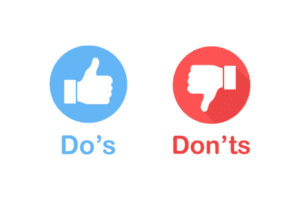
Social Media has its privacy policy that will protect its clients for fraud, vulgar words, discrimination, and any kind of misleading claims or information.
Do’s
- Include a clear call to action.
- Using a clear call-to-action will tell your audience about the purpose of the message and makes them more likely to take action.
- Pick the best image that will stand out – this will represent your brand.
- The newsfeed has a lot of images and advertisements – the challenge is how you will get the audience’s attention. You must select an eye-catching picture and look for the best way on how you can incorporate your brand with the photo.
- Utilize a message that will connect to your audience.
- The concept and message of your ad should be relevant to your target audience in mind. Even if users notice your ad, they likely won’t take action and click on it unless they find it interesting.
- Keep the ads concise and straightforward.
- Your ad mustn’t confuse or overwhelm them. To avoid this from happening, keep your ad simple. Each ad’s intro line and the body of the message should be consistent – paired with a relevant image.
Dont’s
- Do not confuse the audience with elaborate descriptions.
- A creative concept may work for other advertising outlets, a Facebook ad’s message and call-to-action must be secure for a viewer to comprehend within seconds. Additionally, the headline should include the business’s name and product.
- Do not forget to proofread the ad content.
- Reviewing ads twice before publication should be practiced no matter what advertising outlet is using; even large businesses forget to do this.
- Do not use just any advertising image.
- Choose your ad’s image wisely! It should be clear, focused, and of high quality. Your ad’s picture is an essential part of your ad, as it provides the most significant opportunity for your business to grab the attention of its target audience.
- Do not use images that have more than 20% text.
- When it comes to choosing your ad’s image, be sure to select one that is high quality and focused, clean and straightforward, and not more than 20% text.
Targeting the Right Audience

Getting to know your audience is a bit of a challenge for a successful Facebook Ad Campaign. Facebook has billions of active users daily, so you must target only the potential audience that’s interested in your product. Any spectator that is not likely to convert for you is a waste of your advertising dollar.
Surprisingly, Facebook offers a wide variety of range of targeting options that will help you to find the right target niche.
Here are the following ways to improve your targeted audience.
Location-Based Targeting
Facebook can allow you to target people in specific locations, including Country, State/Region, Counties, DMA (Designated Market Area), City, Postal Code, and Specific Address Radius.
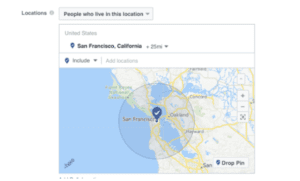
Demographic-Based Targeting
As you click on the Demographics tab, you’ll see a lot of targeting to refine your audience based on your preference. These are the three basic options – Age, Language, and Gender.

Interest-Based Targeting
Interests are one of the best and most comfortable Facebook ads targeting options as they allow you to target people specifically interested in a subject related to your product. For example, you could target people interested in your competitors.
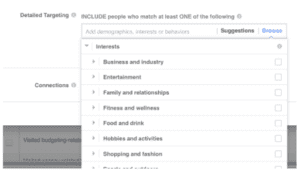
Behavior-Based Targeting
Behaviors allow you to target people by purchase history, events they like, personal anniversaries, etc. This data is gathered by Facebook, analyzing many factors.
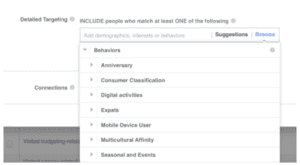
Custom Audiences
This type of Facebook Custom Audience is based on your existing customer files – the lists of email accounts, phone numbers, or Apple IDs. The Custom audience is a great way to target your newsletter subscribers or app users.
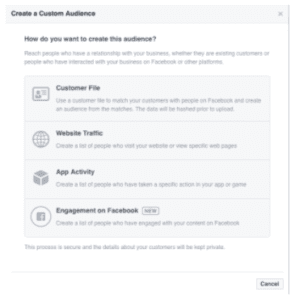
Video Ads

Facebook video ads are one of the most effective advertising formats you can have. Not only are they a great way to show off your brand’s personality and connect emotionally with an audience, but they keep Facebook users’ attention.
Reasons You Should Use Facebook Video Ads
You need to make sure you’re creating video ads that not only appeal to your potential customers but spark an emotional connection. Do it right, and you’ll have no problem boosting audience engagement and driving more valuable conversions.
- Facebook Users Love Video.
- Facebook Video Ads Boost Engagement.
- Facebook Video Ads Drive More Conversions.
Static Ads
On Facebook, one of your options for static image ads includes Page Posts, Page Likes, and Mobile App Install. Depending on the format, they will either reach the News Feed or right-hand side rail on desktop, or just the News Feed on mobile.
Static ads are ads that don’t change. Plain and simple. Most advertisers choose static ads when they want to create awareness around their brand and reach a broad audience. Static ads can be misinterpreted as dynamic ads when a particular static ad showcases a banner or video. These ads are still static, as they do not change over time and sometimes misinterpreted through their dynamic visual elements.
A few benefits of implementing static ads into advertising campaigns is that all advertising networks generally accept them, and they are easy to produce as they do not require much technical or creative expertise. Although static ads are unable to adapt and change according to user behavior, they can be updated and refreshed as needed by the advertiser.
Facebook doesn’t allow ads with images that are more than 20% text. For compliance, you may refer to the Social Media Image Grid.
Conclusion

Creating marketing campaigns that are original, native, timely, and appropriately targeted is your best chance of maximizing paid spots. It’s also worth noting that younger demographics on Facebook have more significant followings — so if you can appeal to the 18-29-year-old set and get them to share your ads, you’re likely to get a nice distribution boost.
Even if your advertisement is a page post video ad (a video ad you post on your Facebook page) Facebook will allow you to reach over one billion users who will be liked, shared, and commented on.
